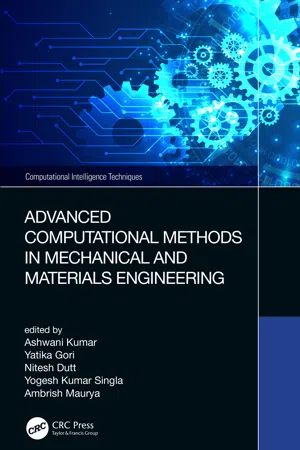
Advanced Computational Methods in Mechanical and Materials Engineering
- 328 pages
- English
- ePUB (mobile friendly)
- Available on iOS & Android
Advanced Computational Methods in Mechanical and Materials Engineering
About This Book
This book provides in-depth knowledge to solve engineering, geometrical, mathematical, and scientific problems with the help of advanced computational methods with a focus on mechanical and materials engineering. Divided into three subsections covering design and fluids, thermal engineering and materials engineering, each chapter includes exhaustive literature review along with thorough analysis and future research scope. Major topics covered pertains to computational fluid dynamics, mechanical performance, design, and fabrication including wide range of applications in industries as automotive, aviation, electronics, nuclear and so forth.
-
- Covers computational methods in design and fluid dynamics with a focus on computational fluid dynamics
-
- Explains advanced material applications and manufacturing in labs using novel alloys and introduces properties in material
-
- Discusses fabrication of graphene reinforced magnesium metal matrix for orthopedic applications
-
- Illustrates simulation and optimization gear transmission, heat sink and heat exchangers application
-
- Provides unique problem-solution approach including solutions, methodology, experimental setup, and results validation
This book is aimed at researchers, graduate students in mechanical engineering, computer fluid dynamics, fluid mechanics, computer modeling, machine parts, and mechatronics.
Frequently asked questions
Information
Section C Materials Engineering
12 Viscoelastic Composites for Passive Damping of Structural Vibration
Contents
- 12.1 Introduction
- 12.1.1 Unconstrained/Constrained Layer Damping Treatment
- 12.1.2 Viscoelastic Composites for UCLD/CLD Treatment
- 12.2 Mathematical Modeling of CLD Treatment
- 12.3 Finite Element Formulation
- 12.4 Numerical Results and Discussion
- 12.4.1 Properties of the Component Materials
- 12.4.2 Damping Analysis of the Layered Plate
- 12.5 Summary
- References
12.1 Introduction
Table of contents
- Cover
- Half Title
- Series Page
- Title Page
- Copyright Page
- Dedication
- Contents
- Introduction
- Preface
- Editors
- Acknowledgements
- Contributors
- Section A Manufacturing Engineering
- Section B Mechanical Design Engineering
- Section C Materials Engineering
- Index